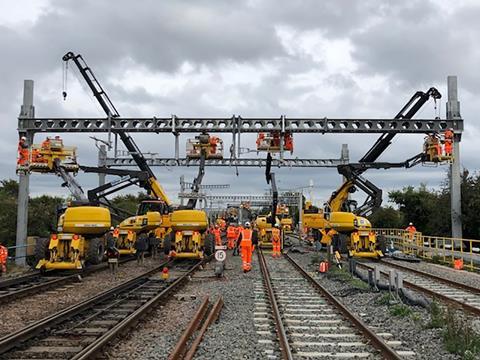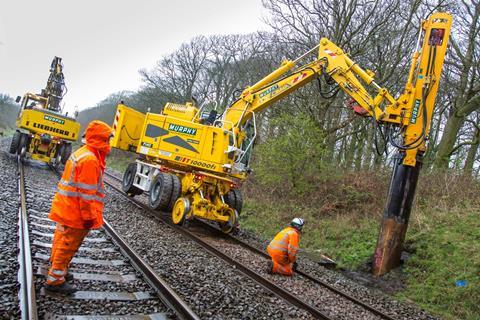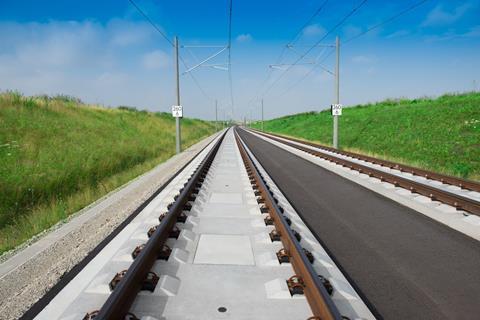
UK: Commitments to electrification, network expansion and modal shift are included in the Decarbonising transport: a better, greener Britain plan published by the government on July 14, along with the selective deployment of hydrogen and battery trains.
‘Transport decarbonisation is a dull way of describing something much more exciting’, said Secretary of State for Transport Grant Shapps. ‘Transport is not just how you get around. It is something that fundamentally shapes our towns, our cities, our countryside, our living standards, our health, and our whole quality of life.’
The multi-modal plan reiterates the government’s commitment to delivering a net zero rail network by 2050, with sustained carbon reductions before then including an ‘ambition’ to remove all diesel-only passenger and freight trains from the network by 2040.
Electrification
Electrification is described as ‘a proven, existing technology’, with a clear record of attracting new passengers and thus decarbonising journeys previously made by road. As such, it is ‘likely’ to be the main way of decarbonising the majority of the network.

The government says it intends to announce further electrification projects shortly, and will also look at options for electrifying the remaining diesel pockets on the third-rail network in the south of England. It aims to ensure that ‘the lessons of previous schemes are learned and that individual projects deliver value for money’, recognising that a sustained programme of electrification provides opportunities to develop supply chain capacity, support long-term skilled employment and reduce costs.
Hydrogen and battery trains would be used where they are appropriate and likely to deliver lower whole-life costs than electrification, with deployment to be guided by Network Rail’s Traction Decarbonisation Network Strategy.
The Department for Transport will also support the use of technology to make diesel trains cleaner until they can be removed altogether.
Capacity
Another commitment covers the provision of additional capacity to meet growing passenger and freight demand and support ‘significant’ shifts from road and air to rail, including the completion of HS2 phases 1 and 2a between London, Birmingham and Crewe by the early 2030s.

The Integrated Rail Plan to be published ‘in due course’ will set out ‘how we will do the later stages of HS2, and Northern Powerhouse Rail, differently’ to speed up the delivery of benefits for passengers, including carbon savings.
The government says it will work with the industry to modernise fares and ticketing. On long distance routes, it believes that flexible pricing will ‘improve choice, offer simple options for passengers and enable cheaper fares at quieter times’, ending sudden price jumps at peak periods. Shorter-distance routes will increasingly move to contactless ticketing.
Further commitments include better connectivity with walking, cycling and other modes, with secure cycle storage, cycle/e-cycle hire, dedicated car-pooling parking spaces, and electric vehicle rental points and charge points to be significantly expanded
Freight
Commitments for the freight sector include the introduction of a growth target and incentives for the early take up of low-carbon traction.

The plan envisages that more electric freight locos will be needed to deliver the emissions benefits from electrification. Short infill wiring projects are planned to deliver benefits quickly by enabling operators to switch to electric traction and eliminate long diesel hauls under the wires.
The government plans to encourage modal shift of freight from road to rail, cargo bikes and inland waterway, through projects such as upgrading the key freight corridor between Southampton and the Midlands and by HS2 releasing capacity on the West Coast Main Line.
The plan says light rail schemes can be ‘transformational’ for highly populated areas. In 2019, the government called for evidence on how to implement and use light rail better, and DfT is using this to inform future policy.
Responses
‘It is really positive to see the Transport Decarbonisation Plan commit to a cost-effective and sustained programme of electrification, and to support the deployment of battery and hydrogen trains’, said Railway Industry Association Chief Executive Darren Caplan. ‘It is also heartening to see the government recognise the role that rail freight can play in cutting emissions, extending to freight the commitment to remove all diesel-only trains from the network by 2040.’

Caplan said ‘suppliers await the details of which schemes will be given the green light and look forward to supporting a rolling programme of electrification.’
Maria Machancoses, CEO of Midlands Connect, said ‘this decisive strategy is what we’ve been waiting for’. She believed that ‘a zero-emission rail network can only be achieved through widespread electrification. We’ve stalled on this for too long – it’s now time to move ahead with development and delivery of a pipeline of projects, starting with the full electrification of the Midland Main Line, and other priority routes across the country.’



